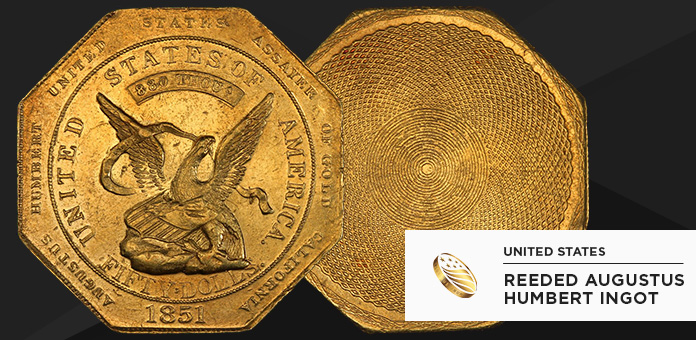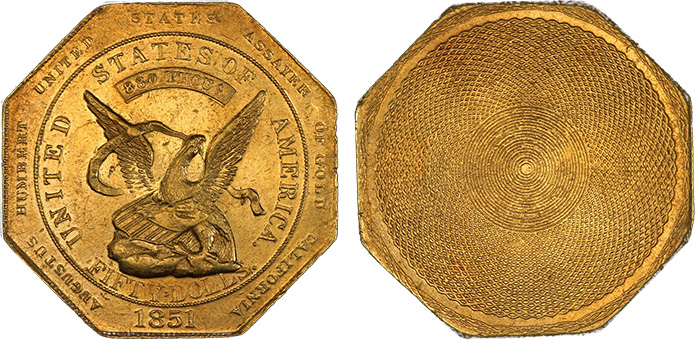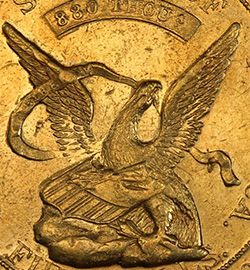
A pristine 1851 “880” Reeded Augustus Humbert $50 gold ingot (slug) is as rare on the modern coin market as federal currency was in California during the days of the Gold Rush.
$50 Gold Ingots: Official Currency for a New State
$50 gold ingots represent a unique time in the history of the U.S. Mint and the state of California. Ripe with gold and rapidly developing, the region lacked statehood status and any official currency in 1849—though it was in dire need of both. Decision makers in Washington responded by admitting California into the Union and permitting the establishment of a U.S. Assay Office in San Francisco in 1850.
New York watchmaker Augustus Humbert was appointed U.S. Assayer and introduced the $50 gold ingot in 1851. While pioneers, bankers, and businessmen alike welcomed a trustworthy and official form of gold currency, the large, octagonal gold pieces proved better for paying Duties at the Port of San Francisco than for everyday commerce. When the U.S. Mint took over the Assay Office in 1853, production of the inventive interim currency ceased and that of less cumbersome 20 dollar gold pieces began.
1851 “880” Reeded Augustus Humbert $50 Gold Ingot: A Distinct & Original Design

The design of the 1851 “880” Reeded Augustus Humbert $50 gold ingot is distinct from that of other contemporary gold coins in that its shape is octagonal rather than circular, and the reverse features several concentric circles instead of a representation of a bald eagle and “United States of America.” Under the Coinage Act of 1792, coins struck by the U.S. Mint were required to have an image symbolizing an eagle and this inscription on the reverse. Federal law also mandated that all coins be produced in an official minting facility. Since the $50 gold pieces were struck in a U.S. Assay office, they were referred to as ingots to avoid legal complications, and perhaps this is why Augustus Humbert took liberties with the artwork.

Depicting a standing eagle clutching the arrows of power and the olive branch of peace in its claws and a scroll with the motto “Liberty” in its beak, the shield of the constitution resting beneath it, the obverse beautifully compresses enough imagery for two coins onto one side. Surrounding the eagle are the standard inscriptions of “United States of America,” and “Fifty Dollars,” as well as “880 Thous,” indicating the ingot is 88 percent pure gold with 12 percent alloy. Further engravings of “Augustus Humbert,” “United States Assayer of Gold California,” and “1851” abut the reeded edges of the octagonal gold ingot.
Interesting Facts about the “880” Reeded Augustus Humbert $50 Gold Ingot
| While “$50 ingot” was this early piece of California currency’s official name, locals also referred to it as a “Californian,” a “five-eagle piece,” a “quintuple eagle,” and a “slug” because of its large size. | |
| The circular design on the reverse was a style popular for watches during that time achieved by a technique called engine-turning—perhaps something Humbert brought to the Assay Office from his watchmaking days. | |
| Consisting of almost two and a half ounces of gold, the $50 ingots were the largest coins circulated during the Gold Rush days. |
Mint State 61 Elevates Rareness
Currently, there are only eight 1851 “880” Reeded Augustus Humbert $50 gold ingots in circulation and only five with a higher mint state than 61, making this particular piece especially rare and collectable. With a unique place in the history of California currency and in pristine condition, the MS-61 1851 “880” Reeded Augustus Humbert $50 gold ingot is a prized addition to any pioneer numismatist’s rare coin collection and a promising endeavor for any investor.
Scottsdale Bullion & Coin is proud to deal in these coveted coins for the right coin connoisseur or investor. If you’re interested in owning a slice of California history or learning more about rare coin collecting in general, contact us today at 1-888-812-9892.

